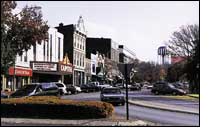Community Profile: Foreign Residents Fill Local Needs in Bowling Green, Ky.
In the movie "Back to the Future," Michael J. Fox's character hops in a DeLorean time machine, speeds for his life, and winds up in a quintessential 1955 version of his hometown. If, by mistake, he had crashed into downtown Bowling Green, Ky., circa 2000, he may have thought he had reached his destination. The statues and greenery of Fountain Square Park, the rows of small businesses, the city hall building on the corner...Bowling Green appears to be as typically mid-American as the fictional Eisenhower-era Hill Valley.
Closer scrutiny, however, reveals an unusual phenomenon in this city of fewer than 50,000 residents. In recent years, Bowling Green has witnessed a steady influx of immigrants, many of whom are refugees looking for a life free of political, racial or religious persecution. This trend has helped to fill job vacancies and add a cosmopolitan flavor to this unassuming southwest Kentucky town.
Why is Bowling Green suddenly home for people who historically have settled in large urban centers like New York, Chicago or Los Angeles? And what effect is their presence having on the local economy?
 |
| Businesses thrive alongside Bowling Green's Fountain Square Park. |
"Very Much in Demand"
Hovering around 2 percent, the unemployment rate in Bowling Green is extremely low by any standard. In Warren County, where Bowling Green is located, the unemployment rate is 3 percent. Each figure sits well below the state unemployment rate of 4.1 percent. Plentiful jobs, along with affordable housing and a low cost of living, have made Bowling Green a prime resettlement area for immigration.
"Even for a person who speaks no English, there are jobs available all over the place right now because times are so good," says Martha Deputy, director of the Western Kentucky Refugee Mutual Assistance Association (WKRMAA), part of a network of 30 agencies that resettles refugees. "These people are very much in demand."
When incorporated in 1981, the WKRMAA began resettling refugees from Vietnam, but has since worked with people from many different countries, including Cambodia, Laos, Mexico, El Salvador, Honduras, Armenia and Russia. The majority of refugees over the past three years have come from Bosnia and Croatia.
Deputy estimates that since June of 1998, she and her staff have brought about 500 refugees into town, compared with about 125 in 1993. There are, she says, currently about 3,000 refugees in all of Warren County. In addition, there is a growing population of nonrefugee immigrants--those who leave their native land not to escape persecution but to seek greater economic prosperity elsewhere.
A Variety of Jobs
Although immigrants make up only a small percentage of the overall population in Bowling Green and Warren County (accurate counts won't be available until the 2000 census is completed), they are quickly filling niches in several industries.
Immigrants are frequently hired at two woodwork companies, Woodwork of Mid-America and Eagle Industries Inc., and also at Trace Die Cast Inc. Restaurants and taverns also offer job opportunities: Because a bulk of the counties surrounding Warren County prohibit alcohol sales, many establishments have sprung up on the south side of town, offering an oasis to travelers along Interstate 65.
Then there are immigrants who have decided to go into business for themselves. Two such men are Roman Safarov, who escaped religious persecution in Armenia seven years ago and now operates his own tool repair business in Bowling Green, and Robert Stupar, a Croatian who is co-owner of The Brickyard Café downtown.
Safarov operated his own automotive repair shop in Armenia and, upon arriving in Bowling Green, set his sights on once again running his own business. He says that living in a smaller town has allowed him to fulfill his dream more quickly.
"What I hear from friends of mine who are in bigger cities is that it took them longer to open their own business," Safarov says.
 |
| Robert Stupar at his downtown café. |
Stupar, who came to Bowling Green five years ago after his brother-in-law moved here from Vermont, says, "I never would have thought a place like Bowling Green would be where I would end up in America, but now that I am here, I know I am in the right place."
If the economy remains strong, even more people from other nations may be beckoned to Bowling Green to rejoin friends and families.
"When jobs are available, word travels," Deputy says.
And indications are that jobs will indeed continue to be available. A diverse group of companies maintain a presence in Bowling Green. General Motors has produced all of its Corvettes in Bowling Green since 1981, and Fruit of the Loom's world headquarters is here. According to the Chamber of Commerce, Bowling Green has attracted 82 corporate facility investments since 1989, though those gains have been offset somewhat by recent plant closings. Holly Performance Products, which is headquartered in Bowling Green and still employs more than 700 people, has closed three plants in town over the past 15 years.
Richard Cantrell, an associate professor of economics at Western Kentucky University in Bowling Green, has closely followed the city's progress over the past two decades. He says that Bowling Green is well positioned to reap the benefits spilling over from the economically potent Nashville market, 60 miles to the south.
"We lie on a large artery that links us to Nashville--I-65," Cantrell says. "Nashville is growing north because most of the land and facilities to the southeast and west have been absorbed. Bowling Green is growing south. By being in the sphere of influence of the tremendous development taking place in Nashville, that is where our best opportunities lie. And that is not a bad place to be."
Blending Together
The proliferation of residents from many different foreign countries in Bowling Green has affected even more than the economy. One illustration of this is the city's International Festival, which began as the Japan Festival in 1989 before conditions required an expanded name. Every October, about 5,000 people attend the celebration in Fountain Square Park. One of the festival's goals is to promote a smoother cultural blend in the town.
One particular area where amalgamating different cultures poses a challenge is in the city's public schools. Of the 3,500 students, 12 percent are enrolled in English as a Second Language courses, the highest percentage of any school district in the state. Only four years ago, that percentage was about 2. More than 20 languages are represented in the district.
"Many of these refugees in our schools have seen war and may never have been in a classroom setting, so meeting their needs is definitely a challenge," says Deborah Williams, chairman of the Bowling Green Board of Education. "If our teachers were not so flexible, I don't know what we would do."
Because Bowling Green is not large enough to be considered a Metropolitan Statistical Area, many forms of federal funding for the school district are unavailable.
"I think we have done as well as we can do with limited funding," Williams says.
The increasing variety of cultures in Bowling Green has also changed the restaurant landscape.
"Twenty years ago, you never would have been able to find a burrito in Bowling Green," Deputy says.
Now, residents can sample foods from around the world at area Mexican, Thai, Japanese, Chinese or Cambodian restaurants.
In general, new residents like Safarov and Stupar say the native citizens of Bowling Green have made them feel welcome. Part of this receptiveness stems from the fact that they are seen as an asset in the effort to fill open jobs. But what if the economy were to turn south again?
Rick Horn, who as director of the Kentucky Small Business Development Center helps to generate additional jobs, fears the atmosphere would change.
"The attitudes of the citizens toward immigrants have been very welcoming, but I think it could be a whole different story if everyone was fighting for the same jobs," he says.
But as long as the economy continues on a vigorous pace, Bowling Green will not have to worry about such conflict between its increasingly diverse mix of residents.
Bowling Green, Ky., by the numbers
| Population | 48,300 |
| Labor Force |
25,427
|
| Unemployment Rate |
1.9%
|
| Per Capita Personal Income | $21,264 |
| Top Five Employers | |
|---|---|
| Western Kentucky University | 2,500 |
| The Medical Center/CHC |
2,195
|
| Warren Co. Board of Education |
1,493
|
| General Motors Corvette Plant |
1,000
|
| DESA International | 800 |
NOTES: Statistics are from June 1999 except for per capita personal income, which is from 1998. The population for all of Warren County in 1998 was 87,323.
Views expressed in Regional Economist are not necessarily those of the St. Louis Fed or Federal Reserve System.
For the latest insights from our economists and other St. Louis Fed experts, visit On the Economy and subscribe.
Email Us

